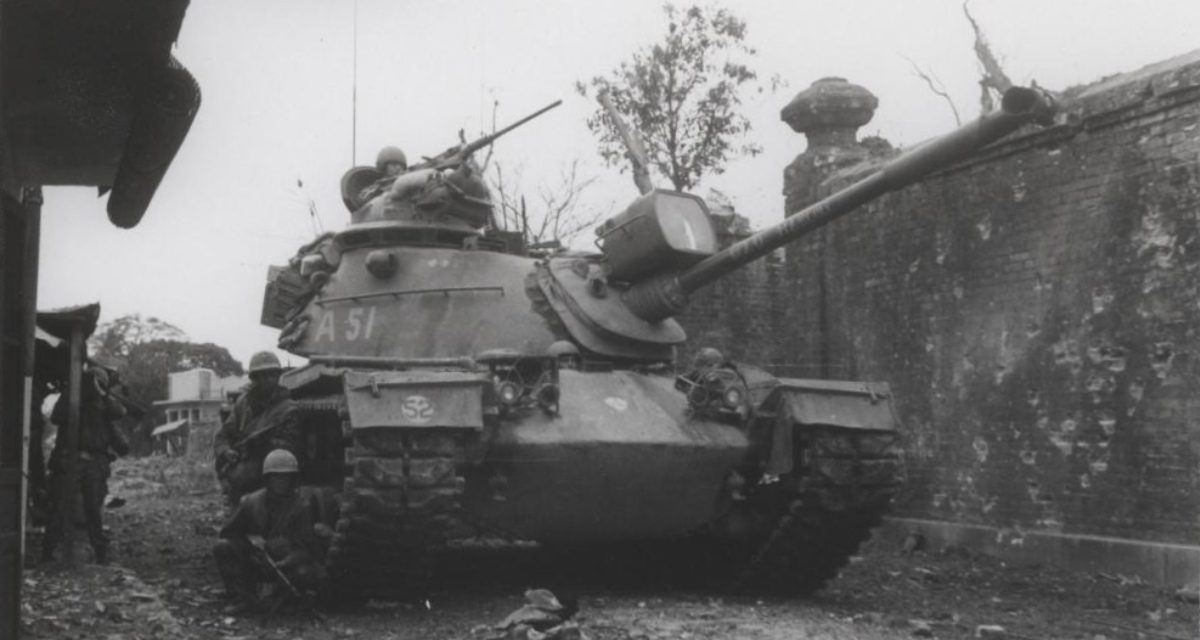in January 1968, North Vietnamese Army and Viet Cong forces launched the Tet Offensive, a series of coordinated attacks aimed at demonstrating to the governments in Washington and Saigon that continuing the war was futile. One of the offensives chief targets was the city of Hue. The fighting that kicked off with the initial attack would last until early March, taking a heavy toll on both sides of combatants, noncombatant residents, and the city itself. But why was it so destructive? And more than a half century on, what lessons should we take from the battle as we prepare for a future of warfare that is increasingly likely to be urban? If military forces find themselves in a future battle like Hue, how can it be fought more effectively, more quickly, and with less damage to the city and its people?
The Modern War Institute recently launched an Urban Warfare Project Case Study Series. The third installment aims to help answer those questions by examining the Battle of Hue.
Like previous case studies focusing on Stalingrad and Mosul, the Battle of Hue also plays an outsized role in the way the US military conceptualizes urban warfare. But, also like Stalingrad and Mosul, Hue was also a fundamentally unique battle in certain key ways, and the case study sheds light on the unique lessons that can be derived from it.
Read the Battle of Hue case study here, and be sure to watch the Urban Warfare Project for upcoming installments in the series.
John Spencer is chair of urban warfare studies at the Modern War Institute, codirector of MWI’s Urban Warfare Project, and host of the Urban Warfare Project Podcast. He previously served as a fellow with the chief of staff of the Army’s Strategic Studies Group. He served twenty-five years as an infantry soldier, which included two combat tours in Iraq.
Major Jayson Geroux is an infantry officer with The Royal Canadian Regiment and currently with 1st Canadian Infantry Division Headquarters. He has been involved in urban operations training for two decades and is an urban operations subject matter expert and urban warfare historian, having participated in, planned, executed, and intensively instructed on urban operations for the past seven years. He has served twenty-six years in the Canadian Armed Forces, which included operational tours to the former Yugoslavia (Bosnia-Herzegovina) and Afghanistan.
A special thanks to Modern War Institute intern Harshana Ghoorhoo, whose initial research and framework of this and following case studies set the conditions for success.
The views expressed are those of the authors and do not reflect the official position of the United States Military Academy, Department of the Army, or Department of Defense, or that of any organization with which the authors are affiliated, including the 1st Canadian Division Headquarters, the Canadian Armed Forces, and the Canadian Department of National Defence.
Image credit: Staff Sergeant J. L. Harlan, US Marine Corps



The study neglects to mention the Cronkite apparently had a change of heart (of some kind) as he reported this 13 days earlier:
https://www.youtube.com/watch?v=TfMocPJZvfQ&t=40s
As one of the CBS News correspondents who covered the Battle of Hue in 1968, I see no contradiction between what Cronkite said about the battle while he was in Viet Nam and what he said in his acclaimed documentary on CBS News some weeks later. I witnessed the fighting in Hue at close quarters and came away with the impression that it was a bloodbath–that neither side "won" or "lost." Of course, the U.S. Marines were proud of their achievement in retaking the territory of the city. One of their battalion commanders, (then) Major Robert Thompson became a close friend during and after the war. He led the Marine push to capture the Citadel on the north side of the Hue river. North Vietnamese casualties were twice those of the Marines, but the number of killed and wounded on both sides was heavy. To isolate the Hue fight and judge it in the context of the overall Viet Nam conflict is a mistake. What happened in Hue in February, 1968, may have been the biggest, longest battle of the war, but it did not represent a contradiction in Cronkite's conclusion that the United States was stuck in a stalemate–both military and political–in the long, deadly Viet Nam War. See my book, "The Cat from Hue: a Vietnam War Story." Part One is entirely about the Battle of Hue.